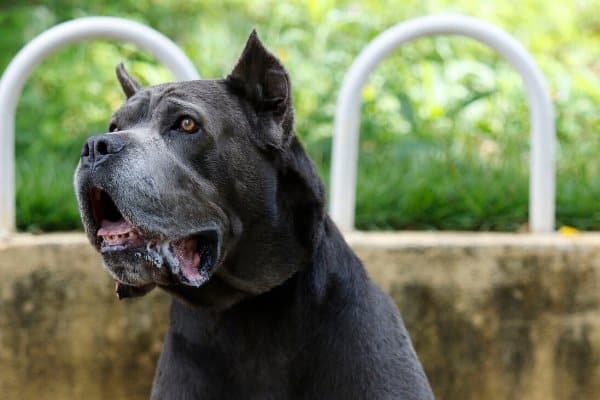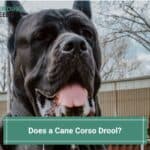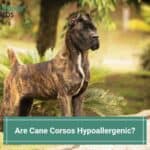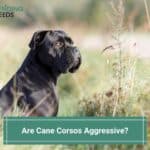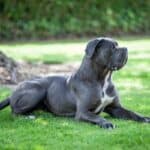Do Cane Corsos drool a lot? People often joke about drooling while gazing through a bakery’s window or planning a special menu for a feast. But, when you reach down to lovingly pet your dog only to have your hand come away with a thick, slimy coating of slobber, it really isn’t all that funny.
So, how does a Cane Corso rank on the slobbering scale?
Large breeds with loose, long jowls, like the Cane Corso, do drool, particularly when food is anticipated or after drinking. Cani Corsi with very floppy jowls will drool a lot while those with tighter, shorter jowls will only drool minimally.
There have been a number of movies, like Beethoven, that featured massive dogs routinely flinging stringy, disgusting trails of drool all over the place. The aim of this grossness was, of course, to elicit a response, like “Yuck!” or laughter, from the viewer.
Effective? Yes.
Pleasant to live with in real life? Not so much.
Let’s take an honest look at what you can expect from a Cane Corso, learn what triggers drooling and when to be concerned. We’ll also give you some tips to help manage the problem.
Why Do Some Cani Corsi Drool More Than Others?
Cani Corsi (also called Cane Corsos in the plural) are Mastiffs and, like all Mastiffs, will drool to some extent, though if you were to survey 100 different Cane Corso owners, you’d receive varying opinions on drooling tendencies.
About a third of owners would claim that their Cane Corsos drool a lot.Another third would claim that their dog hardly drools at all, and the remaining third would state that drooling is moderate, easily managed, and only is evident when food or water is given.
Why?
Well, it all has to do with the size of the dog’s flews, aka upper lips or more commonly, jowls. Simply put, the looser, longer, and floppier a Cane Corso’s jowls are, the more drool can be expected. Conversely, those with tighter, shorter flews will be less likely to drool much.
Now, we should remind you that all dogs salivate (people too). Saliva moistens the mouth, helps to prevent tooth decay and gum disease, and contains enzymes to begin breaking down food in the digestion process.
Dogs with tighter flews are able to contain most of their saliva within their mouths and swallow the excess when necessary.
Loose, flappy jowls, however, don’t form much of a seal around the dog’s mouth, and saliva tends to run down the inner cheeks and drip or form long strands of slimy slobber instead of being swallowed.
Just so you know: hypersalivation, the excessive flow of saliva, is known as ptyalism, and the release of the accumulated excess from the mouth in the form of drooling is called pseudoptyalism.
Breeds like Cane Corsos drool a lot because their long, dangling flaps produce a normal amount of saliva, but their mouth just isn’t capable of holding it in, so the amount of drool only appears excessive.
What Is the Purpose of Those Big Jowls?
Like humans, a dog’s cheeks and lips serve to hold food in the mouth at mealtimes so that it can be chewed properly. Unlike humans, however, a dog’s cheeks are not quite as capable in their function and some pieces of food are dropped when eating and drinking is often a messy endeavor.
In breeds that were sometimes required to face combat, as was the case with Cani Corsi when hunting large game or protecting property, those extra-large jowls served as protection.
If an opponent latched on to the dog’s cheeks, the Cane Corso, thanks to those floppy, long jowls, had enough maneuvering room to bite back and thus free himself.
Fun Fact: On average, Cani Corsi have tighter skin than the other Mastiff breeds and tend to not drool nearly as much comparatively.
What Triggers Drooling?
Excitement, happiness, and panting are a few reasons Cane Corsos drool, because in these situations, the dog’s mouth is open and the saliva isn’t contained.
The scent of food activates the brain to prepare the body for a meal and an increased amount of saliva is produced. Even just the anticipation of food can trigger this response (remember Pavlov’s dogs?).
That’s why many Cane Corsos drool at the exact time they are usually given their meal, even if no food or food odor is present.
Other than the thought of food, drinking water is the other major cause of drooling. The saliva in the dog’s mouth becomes watered-down and flows rather freely down the inner cheeks and out of the mouth.
Owners of Cani Corsi often report long trails of drool on the floor all around their dogs’ water bowls. This is totally normal for breeds with large jowls and is just something that owners have to get used to.
Other Possible Causes of Excessive Drooling and When to Be Concerned
You know your dog better than anyone else does. Any drastic or sudden change that you notice in your dog’s drooling habits may warrant a trip to the veterinarian as a deviance from the norm may indicate an underlying issue.
Unusual drooling that is not normal for your dog may be caused by:
- Dental issues – an abscessed tooth or accumulation of plaque and tartar.
- Ingesting poison – extreme amounts of foamy, frothy drool are often the first indication that a dog has ingested a poisonous substance. Seek emergency help immediately.
- A foreign object – small pieces of bone, wood splinters, shards of a destroyed plastic toy, etc. can become lodged in between a dog’s teeth or in the throat.
- Anxiety – any situation, like heading to the vet for shots, that causes a dog to become nervous.
- Overheating – heavy panting is a dog’s natural way of cooling off, but it is accompanied by an increased amount of drool.
- Excitement – some dogs will drool more heavily when they become excited. This is why guests are so frequently slathered in slobber when greeting your dog.
- Growths- Both harmless lumps and more serious, cancerous growths in a dog’s oral cavity.
- Internal Conditions or infections – kidney or liver issues, transmittable diseases like rabies, upper respiratory infections, seizures, strokes, and other internal conditions.
- Nausea – change in diet, motion sickness, overeating, etc.
With the exception of anxiety and excitement, all of the above possible causes may be quite serious but may be easily resolved by your veterinarian. Don’t delay in seeking treatment. Your vet can even prescribe medications to help with anxiety and excitement if the problem is severe enough.
How to Deal With the Drool
Cane Corsos drool – that’s just a fact of life. Although a Cane Corso’s drooling will never be completely eliminated, there are some measures that you can take to make the situation more manageable and to allow life with a Cane Corso to be more pleasant.
An easy solution is to get in the habit of always having a special “Cane Corsos drool rag” or small towel in your pocket or at least nearby. When those slimy strands first make their appearance, whip out your rag and wipe them away quickly before they are flung around the house or are smeared on your clothes.
Feeding your Cane Corso outside and keeping his water bowls out there too will drastically reduce the amount of drool slung throughout your house. Just remember to wipe his mouth before letting him back indoors.
Another trick is to feed your dog at the same time each day. This way, he will know exactly when to expect his meals and not be forced to wait around for an hour or two, drooling away with expectation, until you remember to give him his dinner.
Tossing bits of food from the table or while you’re preparing a meal may be fun, but this will teach him to expect a tidbit every time. Guess what that will result in?
Yep. Every time human food is being prepared or consumed, Cane Corsos drool. Save the treats for after all food has been put away and then only offer them outdoors to discourage indoor drooling at your mealtimes.

